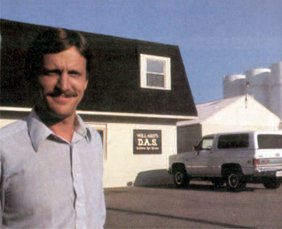The 1980s
Maryland’s Eastern Shore, home to a large portion of the state’s agriculture industry, was a natural area for Willard’s continued growth. In 1982, the company purchased Flo-N-Gro, a liquid fertilizer firm in Lynch, Maryland, from John Byler. Bobby Willard left Frederick to head up the new location. David Baxter, Sr., and Robert Buster Ryans, formerly of Flo-N-Gro, were among the first employees; both are still with Willard.
Bobby Willard, Lynch Plant 1982
With two well-used sprayers and a couple of old trucks, the enterprise struggled at first. We began with a few customers”we had to start over and build our reputation, because integrity and reputation in small communities are just essential, Bobby remembered. It was a difficult beginning. In 1983, the federal government offered PIK (payment in kind) to farmers, paying them not to produce crops because of large existing surpluses. Farmers that did choose to grow suffered from a severe drought that summer. In farming, it all comes down to whether it rains, reflected Bobby. If not, you watch all your year’s work go for naught. The mood here was horrible”we knew farmers were suffering.
Despite the early obstacles, the plant made gains. Lynch has become the company’s single largest location, and maintains a significant market share of the area.
A year later, Willard looked north to Pennsylvania and began to build a new plant in Marion. Supervising design and construction from the outset was Pete Surgeon, an eight-year veteran of Willard. Hired by Larry Martin while he was still in college, Pete was a key figure in the Marion project. De had been through the process before in construction of the Mt. Airy plant. The lessons that he learned during that project were very helpful in the design and layout of Marion, noted Pete. We modified the orientation and layout slightly to fit the Marion site better. De constantly monitored the construction progress, and gave his insight into each phase as needed. At times, he would show up and get his hands dirty, too. The Pennsylvania plant went online in March 1985, just before spring season commenced. The staff included Rob McKoy, Dave White, Nelson Oberholzer and Ronnie Martin, with Larry Tarman joining the next year. Willard customers in the area already numbered more than 100, and the new facility extended Willard’s reach from West Virginia and Maryland north to the Cumberland Valley. Across the country, environmental awareness was beginning to grow. Although Maryland had not yet instituted regulations concerning safety features such as dikes and containment at fertilizer plants, other states had begun to enact them. Willard chose to be proactive in its approach, and asked the Tennessee Valley Authority to conduct a comprehensive assessment at the Frederick location and make recommendations that would enable the facility to exceed the toughest state and federal standards in existence.


